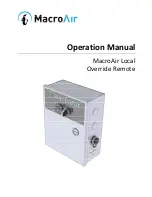
504-2038NUS
11
March 2005
SECTION THREE
SECTION 3: PROCEDURE FOR PERIODIC CHECKING OF
babyPAC 100
1.
Record
Record Qualified Person’s details. Record the serial number of the babyPAC 100 from the label
on the rear of the control module and the serial number(s) of the regulator body(ies).
2.
Check the condition of the Input Hoses
i) From
1
st
January 2002 pressure hoses are date coded and should be replaced after 6 years.
Check the label on hose for replacement date.
ii)
Check that there is no internal damage to the hose by feeling the rigidity of the hose and
looking for sloppiness.
iii)
Ensure there is no delamination of the hose and no blisters or bubbles on the surface (check
again when the hose is pressurised).
iv)
Check union ends for signs of kinking and/or damage to hose or union.
v)
Replace hose if any of above is apparent.
3.
Check the condition of the babyPAC 100
i)
Check the Control Module looking for damage to the gauge and surround, the gas supply
indicators, the gas input and output fittings, the control knobs, the case and labels.
ii)
Check that input and output connections are secure. Tighten if necessary
iii)
Check that the input connector filters are clean.
iv)
Check that the air intake filter is clean, unblocked and secure. Tighten if necessary.
v)
If any of the filters is dirty it should be replaced.
a)
First remove the relevant connector and seal from the Control Module.
b)
The oxygen supply and air intake filters can be replaced by removing the O-ring
(W5520).
c)
The conical filter (W9151) should now be pushed from the connector.
d)
Both O-ring and filter should be replaced.
e)
The air input connector has a retaining circlip holding both O-ring and disc filter.
f)
Drive the filter, O-ring and circlip out of the fitting using a 5mm punch.
g)
Fit new disc filter (W9158) and O-ring (W5523)
h)
Insert a new special retaining circlip (W6487) pushing it down onto the face of the O-
ring using a 6mm punch.
i)
Refit the connector/s with a new sealing washer (W5582/MRI).
vi)
Check that the control knobs move smoothly, are not loose on spindles and do not rub on the
front panel. If spindles are bent the knob may rub on the faceplate on one side only.
vii) Check that the knob caps are affixed firmly to the knob, align with the index mark on the knob
side, and cannot be rotated, relative to the knob, during normal operation.
viii) Rotate each knob to its extreme limits to verify that the knob has not moved on its spindle.
ix)
The T
INS
and the T
EXP
knobs should align exactly with both ends of the calibration marks, i.e.
at 0.25, 2.0 seconds for T
INS
, and 0.25, 4.0 seconds for T
EXP.
Summary of Contents for Pneupac babyPAC 100
Page 2: ...504 2038NUS March 2005 Page Intentionally Blank ...
Page 8: ...504 2038NUS 8 March 2005 Page Intentionally Blank ...
Page 20: ...504 2038NUS 20 March 2005 ...
Page 23: ...504 2038NUS 23 March 2005 Page Intentionally Blank ...
Page 27: ...504 2038NUS 27 March 2005 Page Intentionally Blank ...
Page 31: ...504 2038NUS 31 March 2005 ...












































